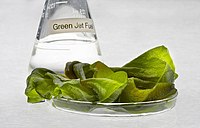
Photo from wikipedia
Microalgae are unicellular photosynthetic organisms capable of producing high-value metabolites like carbohydrates, lipids, proteins, polyunsaturated fatty acids, vitamins, pigments, and other high-value metabolites. Microalgal biomass gained more interest for the… Click to show full abstract
Microalgae are unicellular photosynthetic organisms capable of producing high-value metabolites like carbohydrates, lipids, proteins, polyunsaturated fatty acids, vitamins, pigments, and other high-value metabolites. Microalgal biomass gained more interest for the production of nutraceuticals, pharmaceuticals, therapeutics, food supplements, feed, biofuel, bio-fertilizers, etc. due to its high lipid and other high-value metabolite content. Microalgal biomass has the potential to convert trapped solar energy to organic materials and potential metabolites of nutraceutical and industrial interest. They have higher efficiency to fix carbon dioxide (CO2) and subsequently convert it into biomass and compounds of potential interest. However, to make microalgae a potential industrial candidate, cost-effective cultivation systems and harvesting methods for increasing biomass yield and reducing the cost of downstream processing have become extremely urgent and important. In this review, the current development in different microalgal cultivation systems and harvesting methods has been discussed.
Journal Title: Bioresource technology
Year Published: 2021
Link to full text (if available)
Share on Social Media: Sign Up to like & get
recommendations!